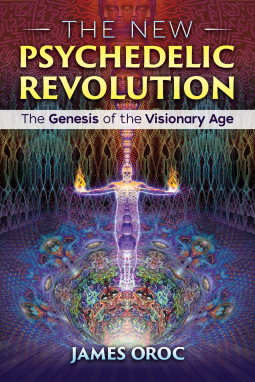
The New Psychedelic Revolution
The Genesis of the Visionary Age
by James Oroc
This title was previously available on NetGalley and is now archived.
Buy on Amazon
Buy on BN.com
Buy on Bookshop.org
*This page contains affiliate links, so we may earn a small commission when you make a purchase through links on our site at no additional cost to you.
Send NetGalley books directly to your Kindle or Kindle app
1
To read on a Kindle or Kindle app, please add kindle@netgalley.com as an approved email address to receive files in your Amazon account. Click here for step-by-step instructions.
2
Also find your Kindle email address within your Amazon account, and enter it here.
Pub Date Jan 16 2018 | Archive Date Dec 12 2017
Inner Traditions | Park Street Press
Description
A bold exploration of modern psychedelic culture, its history, and future
• Examines 3 modern psy-culture architects: chemist Alexander “Sasha” Shulgin, mycologist-philosopher Terence McKenna, and visionary artist Alex Grey
• Investigates the use of microdosing in extreme sports, the psy-trance festival experience, and the relationship between the ego, entheogens, and toxicity
• Presents a “History of Visionary Art,” from its roots in prehistory, to Ernst Fuchs and the Vienna School of the Fantastic, to contemporary psychedelic art
After the dismantling of a major acid laboratory in 2001 dramatically reduced the world supply of LSD, the psychedelic revolution of the 1960s appeared to have finally run its course. But the opposite has actually proven to be true, and a psychedelic renaissance is rapidly emerging with the rise in popularity of transformational festivals like Burning Man and BOOM!, the return to positive media coverage of the potential benefits of entheogens, and the growing number of celebrities willing to admit the benefits of their own personal use. Along with the return of university research, the revival of psychedelic philosophy, and the increasing popularity of visionary art, these new developments signify the beginning of a worldwide psychedelic cultural revolution more integrated into the mainstream than the counterculture uprising of the 1960s.
In his latest book, James Oroc defines the borders of 21st-century psychedelic culture through the influence of its three main architects-- chemist Alexander Shulgin, mycologist Terence McKenna, and visionary artist Alex Grey--before illustrating a number of facets of this “Second Psychedelic Revolution,” including the use of microdosing in extreme sports, the tech-savvy psychedelic community that has arisen around transformational festivals, and the relationship between the ego, entheogens, and toxicity. This volume also presents for the first time a “History of Visionary Art” that explains its importance to the emergence of visionary culture.
Exploring the practical role of entheogens in our selfish and fast-paced modern world, the author explains how psychedelics are powerful tools to examine the ego and the shadow via the transpersonal experience. Asserting that a cultural adoption of the entheogenic perspective is the best chance that our society has to survive, he then proposes that our ongoing psychedelic revolution--now a century old since the first synthesis of a psychedelic in 1918--offers the potential for the birth of a new Visionary Age.
• Examines 3 modern psy-culture architects: chemist Alexander “Sasha” Shulgin, mycologist-philosopher Terence McKenna, and visionary artist Alex Grey
• Investigates the use of microdosing in extreme sports, the psy-trance festival experience, and the relationship between the ego, entheogens, and toxicity
• Presents a “History of Visionary Art,” from its roots in prehistory, to Ernst Fuchs and the Vienna School of the Fantastic, to contemporary psychedelic art
After the dismantling of a major acid laboratory in 2001 dramatically reduced the world supply of LSD, the psychedelic revolution of the 1960s appeared to have finally run its course. But the opposite has actually proven to be true, and a psychedelic renaissance is rapidly emerging with the rise in popularity of transformational festivals like Burning Man and BOOM!, the return to positive media coverage of the potential benefits of entheogens, and the growing number of celebrities willing to admit the benefits of their own personal use. Along with the return of university research, the revival of psychedelic philosophy, and the increasing popularity of visionary art, these new developments signify the beginning of a worldwide psychedelic cultural revolution more integrated into the mainstream than the counterculture uprising of the 1960s.
In his latest book, James Oroc defines the borders of 21st-century psychedelic culture through the influence of its three main architects-- chemist Alexander Shulgin, mycologist Terence McKenna, and visionary artist Alex Grey--before illustrating a number of facets of this “Second Psychedelic Revolution,” including the use of microdosing in extreme sports, the tech-savvy psychedelic community that has arisen around transformational festivals, and the relationship between the ego, entheogens, and toxicity. This volume also presents for the first time a “History of Visionary Art” that explains its importance to the emergence of visionary culture.
Exploring the practical role of entheogens in our selfish and fast-paced modern world, the author explains how psychedelics are powerful tools to examine the ego and the shadow via the transpersonal experience. Asserting that a cultural adoption of the entheogenic perspective is the best chance that our society has to survive, he then proposes that our ongoing psychedelic revolution--now a century old since the first synthesis of a psychedelic in 1918--offers the potential for the birth of a new Visionary Age.
A Note From the Publisher
This is a PDF and not available for Kindle.
This is a PDF and not available for Kindle.
Available Editions
| EDITION | Other Format |
| ISBN | 9781620556627 |
| PRICE | $19.95 (USD) |
| PAGES | 480 |



